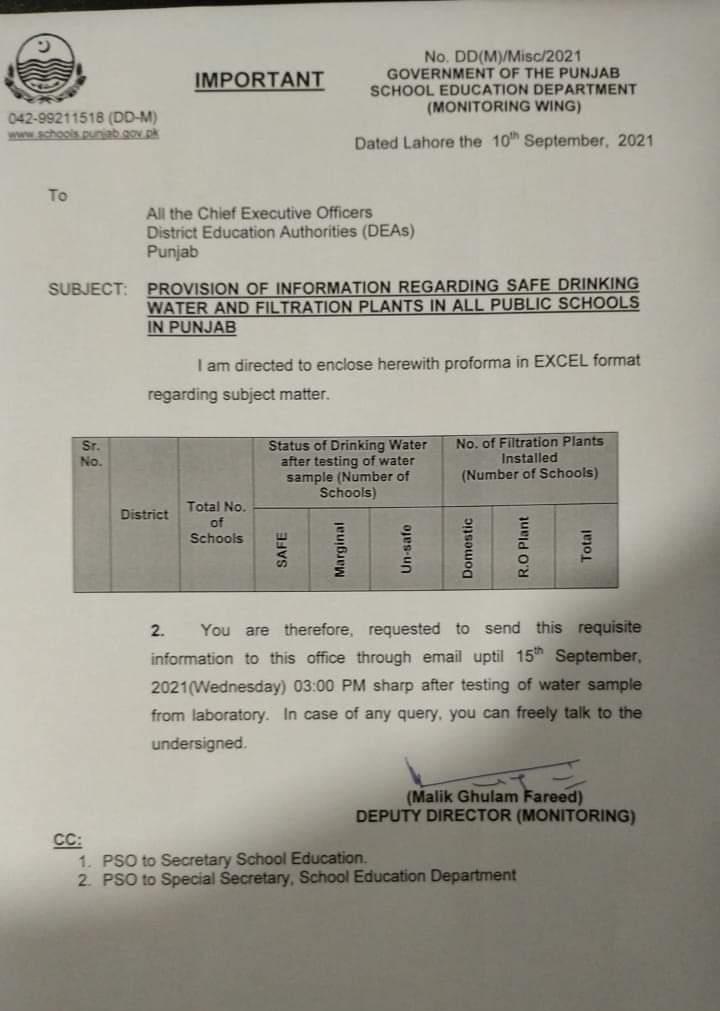
PRICE/RATE LIST OF FILRATION TESTS IN PUNJAB LABORATORIES
| NAME OF TEST | RATEs |
|---|---|
Chemical Analysis with out Sodium Potassium & Nitrate | Rs.500/- per sample |
| Chemical Analysis with Sodium Potassium & Nitrate | Rs.900/- per sample |
| Bacterial Analysis | Rs.500/- per sample |
| Carbonates | Rs.50/- |
| Conductivity | Rs.50/- |
| pH | Rs.50/- |
| TDS | Rs.50/- |
| TSS | Rs.50/- |
| Turbidity | Rs.50/- |
| Total & free chlorine | Rs.100/- |
| Sodium | Rs.100/- |
| Potassium | Rs.100/- |
| Chloride | Rs.100/- |
| Alkalinity | Rs.100/- |
| Bicarbonate | Rs.100/- |
| Calcium Magnesium | Rs.100/- |
| Fluoride | Rs.200/- |
| Hardness | Rs.200/- |
| Iron | Rs.200/- |
| Nitrate | Rs.200/- |
| Nitrite & Sulfate | Rs.200/- |
| Arsenic and other heavy Metal | Rs.500/- |
Cleaning & Disinfection of Water Storage Tanks In Schools
In an emergency situation, it’s far frequently important to quickly offer a simple water deliver for the affected population. This can be due to the fact the ordinary structures of deliver have been broken or destroyed. The maximum common, instantaneously solution is to rent cars and tanks which have been used for other functions or to retrieve collapsible tanks from an emergency store. In both case, they have to be wiped clean and disinfected earlier than being used. This technical word outlines a four-step method to cleansing and disinfecting
STEP-1 (Selection of Concerned Tank)
Tanks need to be decided on primarily based totally on 3 considerations: regular use; ease of cleansing and water storage hygiene. Selected tanks need to best have been used for containing food-grade liquids, for example, milk, cooking oils, fruit juices, wines and spirits or vinegar. Tanks formerly used for containing non food-grade liquids including gas and sewage need to not be used. Tanks that formerly held water however were out of use for a while have to additionally be cleaned and disinfected as described Steps 2 and 3. Tanks have to be smooth to easy. This way they have to be accessible for cleansing and haven’t any sharp corners that can preserve dust and so save you the elimination of food deposits. Water will best stay easy if saved safely. Tanks have to therefore be included and geared up with an get admission to factor with a lockable lid.
STEP-2 (Emptying the tank)
Open the opening valve or faucet and drain out any final liquid. Collect the beverages so they can be properly disposed of (see Step 4). In the case of tankers, outlet valves are generally placed on the back so parking it on a slope will help to make sure that every one the liquid can be discharged . Permanent garage tanks are generally outfitted with a washout valve that attracts liquid from the base. Use this, as opposed to the normal outlet valve, for emptying. Scrub the inner surfaces of the tank Use a combination of detergent and hot water (family laundry soap powder will do) to clean and easy all inner surfaces of the tank. This may be carried out with a stiff brush or a excessive strain jet. Attaching the brush to a protracted pole can also additionally make it viable to easy the tank without coming into it.
STEP-3 (Disinfection of TANK)
The maximum not unusual place manner of disinfecting a water tank is by chlorination. Chlorine is delivered in numerous approaches however the maximum not unusual place is high-energy calcium hypochlorite (HSCH), which, when blended with water, liberates 60 to 80% of its quantity as chlorine.
Calculate the quantity of the tank
The quantity of chlorine wished to disinfect the water tank will depend on its quantity. And joints in order that no small quantities of the authentic liquid remain. Even minute quantities of a few liquids can deliver the water a terrible flavor and humans will refuse to drink it. Leave the hole valve open while cleansing and accumulate the liquid for secure disposal.

Calculation Method for Volume of Tank to be disinfected
Wash and flush the tank
This is maximum effortlessly executed with a high stress hose pipe or water jet but if they may be now no longer to be had the tank can be crammed with (ideally hot) water and left to face for some hours. Drain all of the water from the tank and accumulate for secure disposal as before. Continue flushing the tank till there are not strains of detergent in the water.

Clean hoses
The hoses, pumps and pipes used for filling and emptying the tank need to additionally be cleaned. Flush a combination of warm water and detergent via the pipes and pump to do away with deposits and different waste material. Once cleaned, flush the device with smooth water to do away with the detergent
Add the disinfectant
Fill the tank 1 / 4 complete with smooth water. Sprinkle eighty grams of granular HSCH into the tank for each 1000 liters general capability of the tank. Fill the tank absolutely with smooth water, near the lid and depart to face for 24 hours. If the tank is needed for use urgently, double the amount of chlorine brought to the tank. This will lessen the time of disinfection from 24 to eight hours.
Disinfecting the hoses and pump
If the tank is geared up with a pump, join the hoses in order that water is drawn from and lower back to the tank . With the tank complete of water and disinfectant, begin the pump in order that the combination passes via the hoses and pump. Run the pump for approximately an hour. Repeat this technique with the tank complete of smooth water. If no pump is geared up, use a number of the disinfectant from the tank and gently fill the hoses to complete capability. You will ought to block one give up of the hose and fill it from the alternative give up. Allow to stand for twenty-four hours. Empty out the disinfectant and join the hoses to the tank outlet so that after the smooth water in the tank is discharged it passes via the hoses. The hoses at the moment are geared up for use.
Prepare for use
Completely empty the tank and cautiously eliminate the disinfecting water because it will include a high attention of chlorine. Fill the tank with drinking-water, permit to stand for approximately half-hour then empty the tank again. The tank is now geared up for use.
STEP-4: Safely disposing Liquid waste-Material
Care need to be taken whilst disposing of all beverages used for cleansing and disinfecting the tanks. Sudden discharge of water will cause localized erosion or flooding. Make positive the water follows a channel to its very last disposal point. Liquid waste must now no longer be disposed of in rivers and ponds because the natural substances and high chlorine stages may also kill fish and plant life. Wastewater must be disposed of to a sewer network, carried in tankers to a sewage treatment plant or positioned in a septic tank that overflows into an underground soakage system.




Wonderful website. There is a wealth of helpful information available here. I’m sending it to a few friends and sharing it on Delicious. And of course, thank you for your effort!I blog quite often, and I seriously thank you for your information. This article has truly piqued my interest. I will bookmark your site and check for new details once a week. I opted in for your RSS feed as well.
Thnks for info